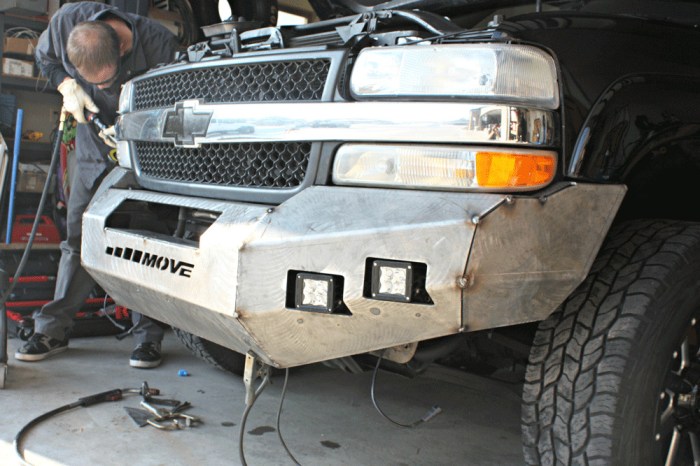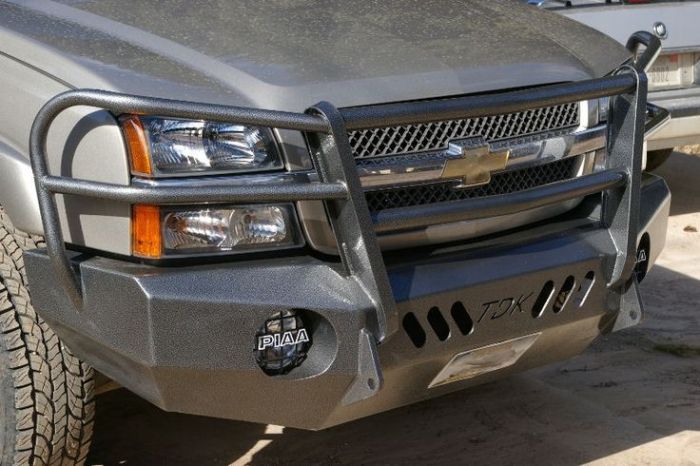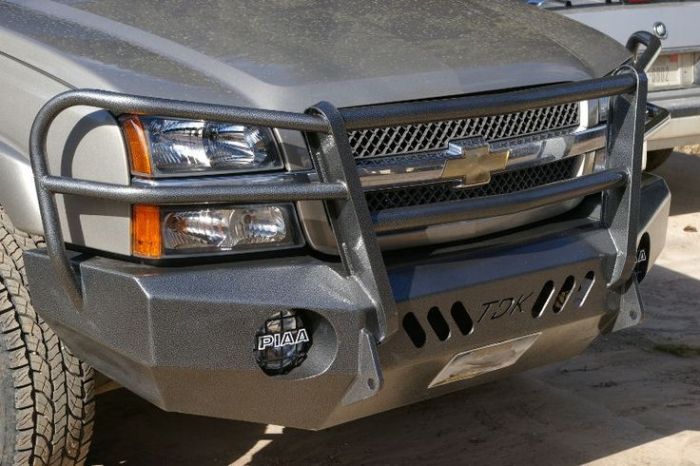DIY bumper kits offer a thrilling way to customize your vehicle and enhance its off-road capabilities. These kits provide the necessary components and instructions to install a sturdy bumper that not only adds protection but also allows for personalization with lights, winches, and other accessories.
From steel to aluminum and fiberglass, each material brings unique advantages and drawbacks. Understanding your vehicle’s needs, intended use, and budget is crucial when choosing the right kit. Whether you’re a seasoned off-roader or a novice enthusiast, the world of DIY bumper kits opens a door to exciting possibilities.
Customization Options
A DIY bumper kit provides a blank canvas for you to create a unique and functional bumper that perfectly suits your vehicle and needs. The possibilities for customization are practically limitless, allowing you to express your personal style and enhance your vehicle’s capabilities.
Adding Lights
Adding lights to your DIY bumper can significantly improve visibility and safety, especially during nighttime driving or off-road adventures. You can choose from various types of lights, such as:
- LED light bars: These are popular for their brightness, durability, and energy efficiency. They can be mounted on the top, bottom, or sides of the bumper.
- Fog lights: These lights provide better visibility in foggy conditions and can be mounted on the lower corners of the bumper.
- Auxiliary lights: These lights can be used for various purposes, such as providing additional illumination for off-road driving or illuminating work areas.
When selecting lights, consider factors such as the size, brightness, beam pattern, and mounting options. You can find a wide range of lights from reputable brands like Rigid Industries, Baja Designs, and KC Hilites.
Adding a Winch
A winch can be a lifesaver in off-road situations, allowing you to pull your vehicle out of mud, sand, or other obstacles. Adding a winch to your DIY bumper can provide a secure and convenient mounting point.
- Winch size: The winch size you need will depend on the weight of your vehicle and the terrain you plan to drive on.
- Winch mounting plate: This plate is used to attach the winch to the bumper. It’s essential to choose a plate that is compatible with your winch and bumper.
- Winch control: You can choose between wired or wireless controls. Wireless controls offer greater convenience, but wired controls are generally more reliable.
It’s crucial to ensure that the winch is properly installed and tested before using it.
Adding Other Accessories
Besides lights and winches, you can add various other accessories to your DIY bumper, such as:
- Recovery points: These are strong points on the bumper that can be used to attach recovery straps or chains.
- Tire carriers: These carriers can be used to mount spare tires on the bumper.
- Tool boxes: These boxes can be mounted on the bumper to store tools and other gear.
- Steps: Steps can be added to the bumper to make it easier to access the roof of your vehicle.
These accessories can enhance your vehicle’s functionality and make it more versatile for off-road adventures or everyday use.
Examples of Unique DIY Bumper Designs
The possibilities for customizing DIY bumper designs are endless. Some popular examples include:
- Bumper with integrated light bars: This design incorporates LED light bars directly into the bumper, creating a sleek and functional look.
- Bumper with a built-in winch mount: This design integrates a winch mount into the bumper, providing a secure and aesthetically pleasing solution.
- Bumper with a tire carrier: This design incorporates a tire carrier into the bumper, allowing you to mount a spare tire on the back of the vehicle.
- Bumper with a built-in toolbox: This design incorporates a toolbox into the bumper, providing convenient storage for tools and other gear.
These are just a few examples, and you can find many more inspiring designs online or in automotive magazines.
Resources for Finding Custom Parts and Accessories
There are numerous online and offline resources where you can find custom parts and accessories for your DIY bumper. Some popular options include:
- Online retailers: Websites like Amazon, eBay, and Summit Racing offer a wide selection of parts and accessories.
- Specialty stores: Stores that specialize in off-road equipment, such as 4 Wheel Parts and Quadratec, offer a wide range of parts and accessories.
- Local fabricators: Local fabricators can create custom parts and accessories to your specifications.
It’s essential to research and compare prices before purchasing any parts or accessories.
Maintenance and Care
A DIY bumper kit, like any other automotive part, requires proper care and maintenance to ensure its longevity and optimal performance. By following a few simple steps, you can keep your bumper looking its best and prevent potential problems.
Cleaning and Protection
Regular cleaning is essential to maintain the appearance and protect your bumper from damage.
- Use a mild soap and water solution to wash the bumper, avoiding harsh chemicals or abrasive cleaners that can damage the finish.
- Rinse the bumper thoroughly with water to remove any soap residue.
- Dry the bumper with a soft cloth to prevent water spots.
- Apply a layer of car wax or sealant to protect the bumper from UV rays, scratches, and other environmental damage.
Common Problems and Troubleshooting
While DIY bumper kits are generally durable, some common problems can arise.
- Scratches: Minor scratches can be removed with a polishing compound or a touch-up paint pen. For deeper scratches, professional repair may be necessary.
- Cracks: Cracks can be repaired using epoxy resin or a fiberglass repair kit. Ensure the surface is clean and dry before applying the repair material.
- Fading: UV exposure can cause the bumper to fade over time. Applying a UV-resistant sealant can help prevent fading.
Corrosion
Corrosion can occur on metal bumpers, especially in areas exposed to salt or moisture.
- Regularly inspect the bumper for signs of rust or corrosion.
- Clean any rust with a wire brush and apply a rust converter to prevent further corrosion.
- Apply a protective coating, such as a sealant or paint, to prevent future corrosion.
Damage
Severe damage, such as dents or cracks, may require professional repair.
- Avoid using excessive force to remove dents or repair cracks, as this can further damage the bumper.
- Contact a qualified auto body shop for professional repair.
Legal Considerations
Modifying your car’s bumper can be exciting, but it’s crucial to understand the legal aspects involved. Failing to comply with local regulations could lead to fines, legal issues, and even the refusal of insurance claims in case of accidents.
Safety Concerns Related to Improper Installation
Improper installation of a DIY bumper kit can pose serious safety risks. A poorly fitted bumper might not provide adequate protection in case of a collision, potentially leading to more severe injuries for you and other road users.
It is crucial to ensure the bumper is securely mounted and meets the minimum safety standards set by your local authorities.
Resources for Finding Legal Guidelines and Safety Standards
- Local Department of Motor Vehicles (DMV): The DMV website or office is the primary source for information on vehicle modifications and safety regulations in your area. They can provide you with specific guidelines on bumper modifications, including size, material, and installation requirements.
- National Highway Traffic Safety Administration (NHTSA): The NHTSA provides comprehensive information on vehicle safety standards and regulations. Their website includes resources on bumper safety, including crash test data and guidelines for manufacturers.
- Professional Automotive Organizations: Organizations like the National Automobile Dealers Association (NADA) and the Automotive Service Association (ASA) often offer resources and guidelines for vehicle modifications. They can provide insights into industry best practices and safety standards.
DIY Bumper Kit vs. Professional Installation: Diy Bumper Kits

Installing a new bumper can be a great way to enhance your vehicle’s appearance and protection. You have the option of doing it yourself with a DIY bumper kit or hiring a professional. Both options have their pros and cons, and the best choice for you will depend on your budget, time commitment, and technical skills.
Cost Comparison, Diy bumper kits
The cost of installing a bumper kit can vary significantly depending on the type of kit, the vehicle, and the labor costs. DIY kits are typically the most affordable option, as you only need to pay for the kit itself. However, you’ll need to factor in the cost of any tools or supplies you may need. Professional installation, on the other hand, will include the cost of the kit plus the labor charges.
- DIY Bumper Kits: Typically range from $100 to $500, depending on the complexity of the kit and the materials used.
- Professional Installation: Can cost anywhere from $200 to $1000 or more, depending on the complexity of the installation, the location, and the experience of the mechanic.
Time Commitment
Installing a DIY bumper kit can take anywhere from a few hours to a full day, depending on your experience and the complexity of the kit. If you’re not familiar with automotive repair, it’s best to allocate more time for the project. Professional installation typically takes less time, as mechanics are experienced and have the right tools for the job.
- DIY Bumper Kits: Expect to spend several hours to a full day, depending on your experience and the complexity of the kit.
- Professional Installation: Typically takes a few hours, depending on the complexity of the installation and the mechanic’s availability.
Technical Skills Required
Installing a DIY bumper kit requires basic automotive knowledge and some mechanical skills. You’ll need to be comfortable working with tools, following instructions, and making precise measurements. If you’re not confident in your abilities, it’s best to hire a professional. Professional installation requires extensive knowledge of automotive repair and the ability to use specialized tools.
- DIY Bumper Kits: Basic automotive knowledge, comfort with tools, and ability to follow instructions are required.
- Professional Installation: Requires extensive automotive repair knowledge, specialized tools, and experience.
When Professional Installation is Recommended
There are several situations where professional installation is recommended:
- Complex Installations: If the bumper kit is complex or requires specialized tools, professional installation is highly recommended.
- Limited Time: If you don’t have the time to install the bumper yourself, professional installation is a more convenient option.
- Lack of Experience: If you’re not comfortable working on your vehicle, professional installation will ensure the job is done correctly.
- Warranty Concerns: Some manufacturers may void warranties if you install the bumper yourself.
Community and Resources
Joining a community of off-road enthusiasts can be a valuable resource for DIY bumper kit owners. These communities provide a platform for sharing knowledge, tips, and experiences, helping you navigate the world of off-roading with confidence.
Online Forums and Communities
There are numerous online forums and communities dedicated to off-roading and DIY projects. These platforms offer a wealth of information, including:
- Technical advice and troubleshooting: Connect with experienced off-roaders who can provide guidance on installation, repairs, and modifications.
- Product reviews and recommendations: Get insights from fellow enthusiasts on the best bumper kits, accessories, and tools for your vehicle.
- Trail reports and trip planning: Discover new off-roading destinations and share your own experiences with the community.
- Project showcases and inspiration: Find inspiration from others’ builds and learn from their successes and mistakes.
Popular Off-Roading Websites
- Off-Road.com: A comprehensive website offering news, reviews, forums, and a vast library of off-roading information.
- Expedition Portal: A popular forum and website focused on expedition-style off-roading, with a strong emphasis on DIY projects and overland travel.
- JeepForum.com: A dedicated forum for Jeep owners, covering all aspects of Jeep ownership, including off-roading and DIY projects.
- Toyota Nation: A forum specifically for Toyota owners, with a dedicated section for off-roading and modifications.
Sharing Your Experiences and Asking Questions
Don’t hesitate to share your own experiences and ask questions in these online communities. Your contributions can benefit others and help build a strong and supportive off-roading community.
Conclusion

Customizing your vehicle with a DIY bumper kit can be a rewarding experience, allowing you to personalize your ride while potentially saving money compared to professional installation. This guide has explored the various aspects of DIY bumper kits, from choosing the right kit to installing it safely and legally.
Remember, the key to a successful DIY project is careful planning, preparation, and attention to detail. By following the instructions, taking your time, and seeking assistance when needed, you can confidently tackle this project and enjoy the results for years to come.
With careful planning, a DIY bumper kit can transform your vehicle’s appearance and performance. The process, while demanding, offers a rewarding experience of building and customizing your own off-road protection. Remember to prioritize safety, adhere to local regulations, and explore the vast community of DIY enthusiasts for support and inspiration.
DIY bumper kits can be a great way to personalize your vehicle and protect it from minor bumps and scratches. However, if you’re looking to enhance your physique, you might consider exploring options like nolvadex , which can be a helpful tool for some individuals. But remember, it’s always important to consult with a medical professional before starting any new supplement regimen.
Returning to the topic of DIY bumper kits, you’ll find that there are a wide variety of materials and styles available, so you can find the perfect fit for your needs and preferences.

